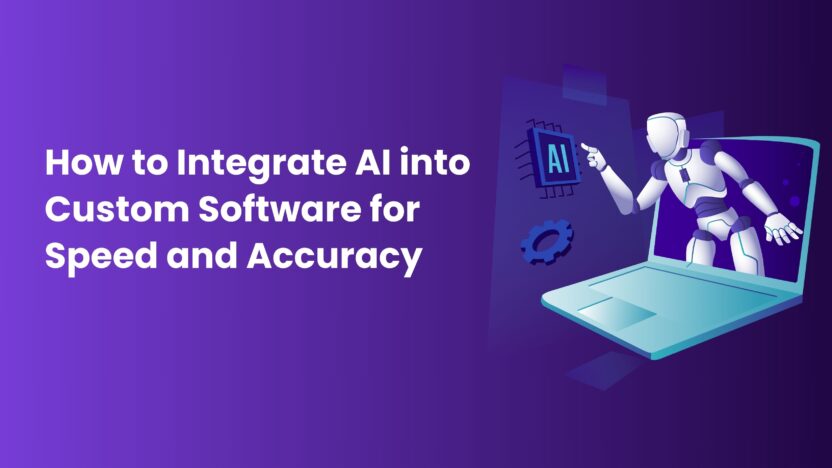Custom software is evolving, and AI is leading the charge. Today, companies across industries want smarter tools, faster development, and decisions driven by real data. This is where artificial intelligence comes into play.
Integrating AI into custom software isn’t just about automation. It’s about using intelligent systems to enhance performance, streamline operations, and personalize user experiences. From startups to enterprises, more teams are looking at AI to solve their most pressing challenges.
In this blog, we’ll explore the most effective ways to integrate AI into your software development process, discuss the top AI features, and outline real business use cases.
Why Integrate AI in Custom Software?
Traditional software solves static problems. AI-driven software adapts, learns, and improves over time. That’s a game changer.
Here are key reasons why AI is essential in modern software:
- Faster decisions: Algorithms analyze data faster than humans.
- Personalized experiences: AI tailors content and actions to user behavior.
- Predictive power: Forecast trends, behaviors, or system failures in advance.
- Increased productivity: Automate repetitive tasks like data entry or quality checks.
AI turns software into a proactive business tool rather than just a digital product.
Key Features of AI in Software Development
Let’s explore which AI capabilities are worth integrating:
1. Machine Learning (ML)
Train your app to recognize patterns and make intelligent predictions. ML can enhance search results, fraud detection, and customer segmentation.
2. Natural Language Processing (NLP)
Power chatbots, virtual assistants, and smart search functions with NLP. Let your software understand and respond in human language.
3. Computer Vision
Apps using cameras or image input can use AI to identify objects, faces, or even medical scans.
4. Predictive Analytics
Turn historical data into actionable forecasts. Whether it’s predicting demand or flagging risks, AI makes your software smarter.
5. Generative AI
Use tools like OpenAI or Stable Diffusion to auto-generate text, images, or content suggestions. Especially useful in content, marketing, and design platforms.
When to Integrate AI in Software Development
AI isn’t a plugin. It should be part of your software strategy from the start.
Key phases to consider AI integration:
- Planning: Identify which parts of your workflow need intelligence or automation.
- Design: Build UI/UX that supports AI features like voice commands or real-time suggestions.
- Development: Embed ML models, connect to APIs, or use libraries like TensorFlow or OpenAI.
- Testing: Use AI to run simulations, detect bugs, and optimize performance.
- Post-launch: Analyze user behavior and retrain your models to improve over time.
How to Integrate AI: A Step-by-Step Approach
Step 1: Define Your Use Case
Start with clear goals. What should AI do in your app? Automate support? Improve recommendations? Reduce downtime?
Step 2: Choose Your AI Tools and Frameworks
Popular choices include:
- TensorFlow, PyTorch for ML
- Hugging Face, OpenAI for NLP
- Dialogflow, Rasa for chatbots
- Google Vision API for image analysis
Step 3: Prepare Quality Data
AI thrives on data. Make sure you clean, label, and structure your datasets correctly.
Step 4: Build, Train, and Validate Models
You can use pre-trained models or build custom ones. Either way, testing for accuracy is key.
Step 5: Deploy and Monitor
Launch your AI features alongside the app. Use dashboards to track model performance and retrain when needed.
Real Business Use Cases: Generative AI in Action
Healthcare
AI chatbots guide patients, while ML helps predict illnesses based on medical records.
Retail
Smart recommendations based on browsing behavior boost conversions.
Finance
AI detects fraud in real time and automates credit scoring.
Manufacturing
Predictive maintenance reduces downtime by flagging equipment issues before they happen.
Common Challenges and How to Overcome Them
| Challenge | Solution |
| Data Privacy | Use encryption and comply with laws like GDPR or HIPAA. |
| Model Bias | Regularly audit models to remove bias and retrain them on diverse data. |
| Scalability | Use cloud-based solutions to manage demand and data. |
| Integration Complexity | Partner with AI-savvy developers or firms that understand both code and data. |
Generative AI and Workflow Automation
Generative AI isn’t just about writing text. It’s streamlining business processes:
- Content creation: Auto-generate marketing assets, reports, or product descriptions.
- Code assistance: Use tools like GitHub Copilot to reduce developer workload.
- Customer service: Combine AI with support workflows to solve problems instantly.
Businesses that integrate AI at the workflow level report higher ROI and lower operational cost.
Why Partnering with the Right Development Team Matters
AI projects need deep expertise in both coding and machine learning. That’s why many businesses choose a custom software development company to lead the integration.
Benefits of a skilled partner:
- Faster implementation
- Proven use of AI frameworks
- Scalable backend architecture
- Cost-effective, future-ready builds
If you’re looking for an affordable mobile app development company that also understands AI, make sure they’ve delivered similar intelligent solutions.
Make a smarter move!
Integrating AI into custom software is one of the smartest moves a business can make in 2025. It improves speed, accuracy, and user engagement across every touchpoint.
Whether you’re adding predictive analytics, natural language processing, or generative AI, the right approach can future-proof your product and improve outcomes.




